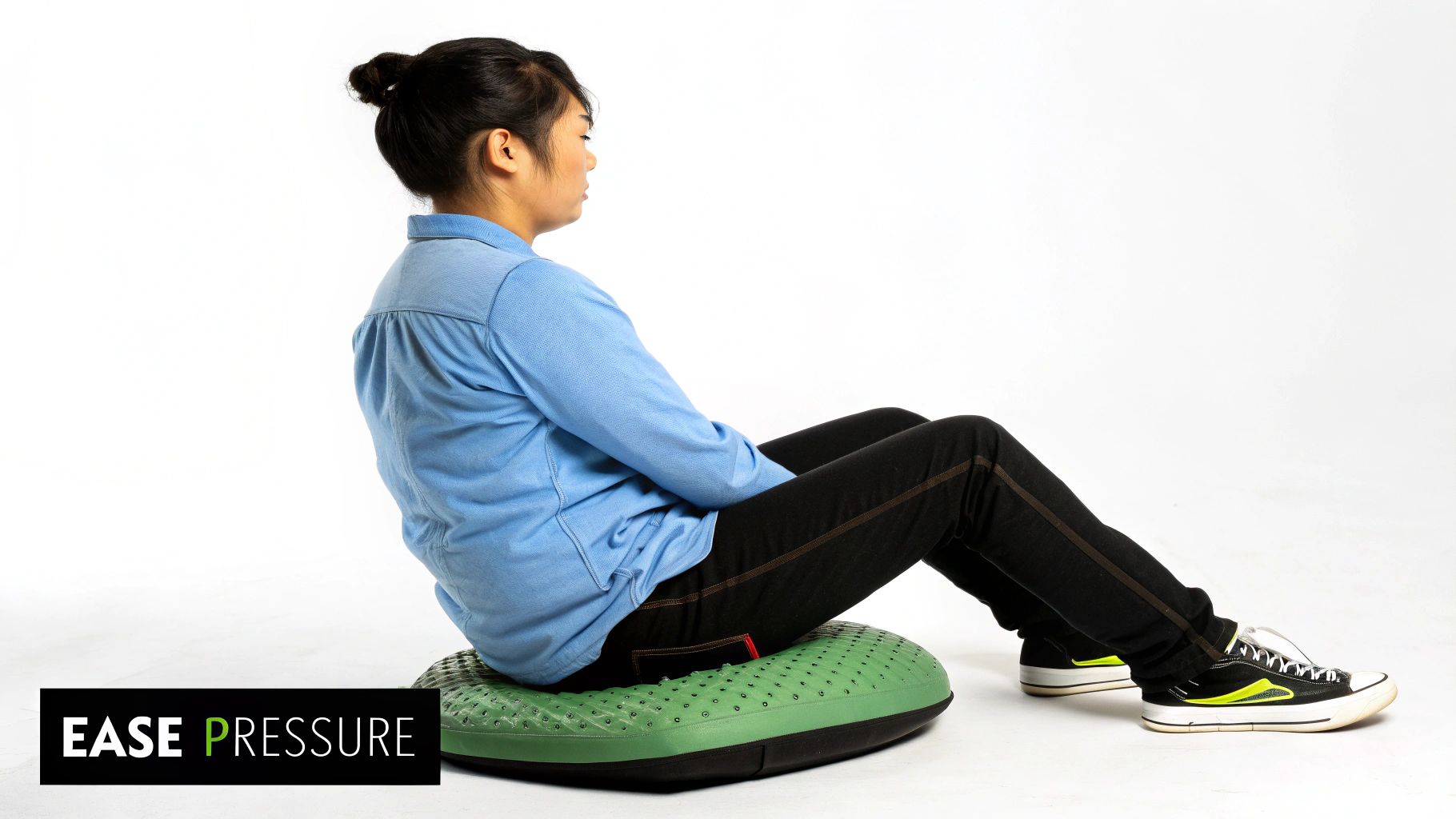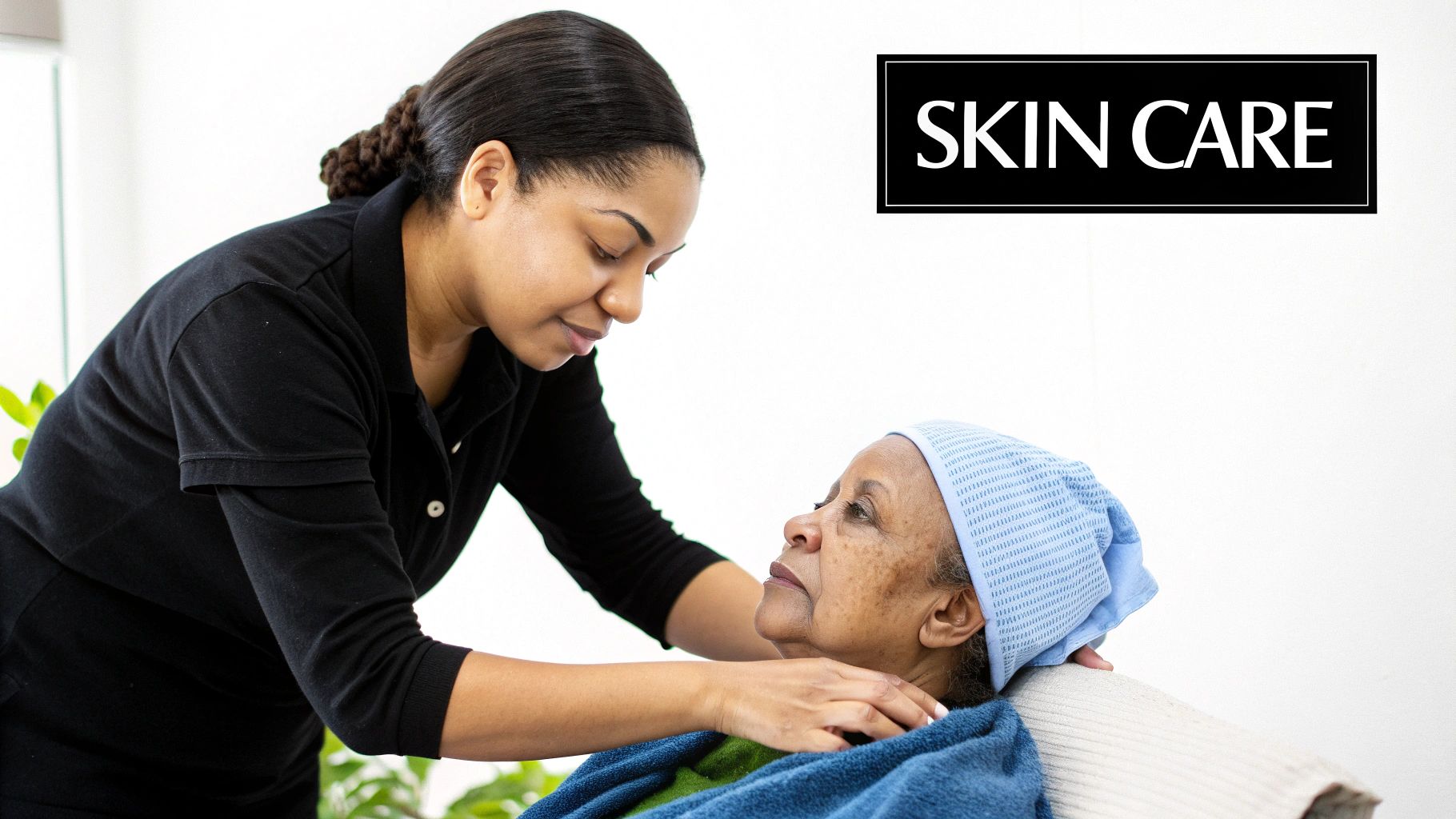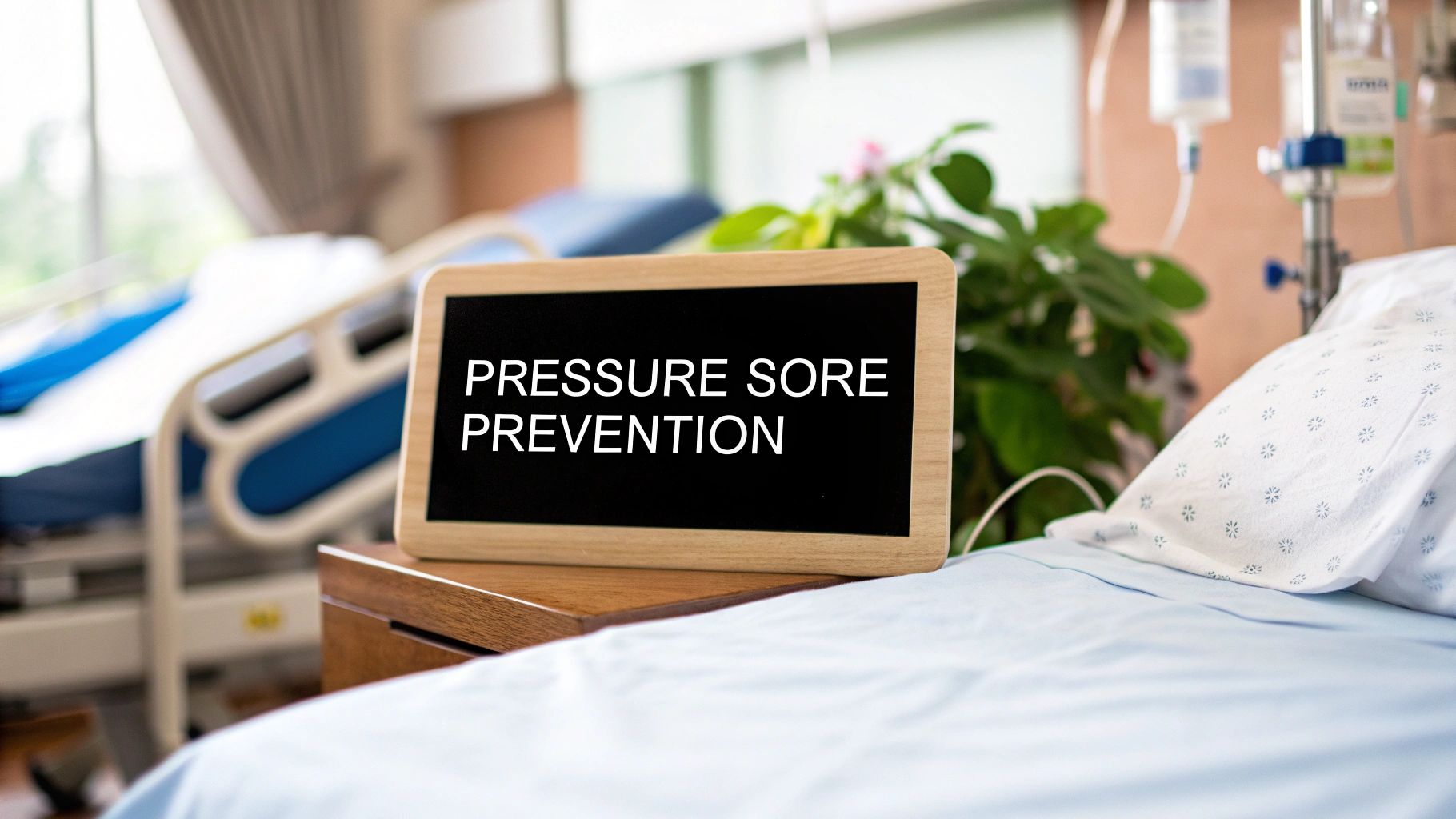Despite advancements in medical technology and patient care, pressure sores (also known as pressure ulcers or pressure injuries) continue to be a significant challenge in healthcare. These wounds, developing from prolonged pressure on the skin and underlying tissues, affect millions of people globally. This raises a crucial question: why do these often preventable injuries persist in our era of advanced medical care?
Understanding the Underlying Mechanisms
A key reason for the persistence of pressure sores is the complex interplay of physiological factors contributing to their development. Sustained pressure on bony areas, such as the heels, hips, and tailbone, restricts blood flow. This lack of blood flow deprives the tissues of essential oxygen and nutrients, resulting in ischemia (restricted blood supply) and potentially tissue death.
Friction and shear, frequently occurring during patient transfers or repositioning, further compound the problem. Even seemingly minor movements can disrupt the delicate balance and contribute to tissue breakdown, increasing the risk of pressure sores.
The Vulnerable Population: Who Is Most at Risk?
Some groups face a significantly elevated risk of developing pressure sores. Older adults, individuals with limited mobility, and those with underlying conditions like diabetes or malnutrition are particularly vulnerable. For instance, people with diabetes often have impaired circulation and decreased sensation, hindering their ability to detect early warning signs.
Immobility, whether from illness, injury, or surgery, dramatically increases the risk. This underscores the necessity of targeted prevention strategies for these high-risk individuals.
The Prevalence of Pressure Sores: A Persistent Challenge
Preventing pressure sores presents a significant challenge in modern healthcare. The global prevalence of pressure ulcers is estimated at 12.8%, with hospital-acquired pressure injuries (HAPIs) making up roughly 8.4% worldwide. In the U.S. alone, over 2.5 million pressure ulcers are treated every year. These ulcers are more frequent in older populations and those with limited mobility due to chronic health issues.
Despite medical progress, pressure injury rates remain relatively steady. This is partly because many ulcers are stage I or II, often overlooked without prompt identification. Common prevention strategies include frequent repositioning, specialized mattresses, and meticulous skin care. More information on pressure sore prevalence can be found here: https://pmc.ncbi.nlm.nih.gov/articles/PMC9275412/
Missed Opportunities: Early Detection and Intervention
Early detection is vital in preventing pressure sores from worsening. Subtle early signs, like skin discoloration or changes in temperature or texture, can be easily missed in busy clinical settings. This highlights the need for comprehensive and regular skin assessments, especially for high-risk patients. Open communication between healthcare providers, patients, and caregivers is crucial for timely intervention and effective prevention. Understanding these underlying causes and vulnerabilities is the first step toward preventative measures. This knowledge empowers healthcare professionals and caregivers to prioritize patient well-being and minimize the occurrence of pressure sores.
The Economics of Prevention: Saving More Than Just Skin

Pressure sores place a significant financial strain on healthcare systems, families, and individuals. These costs extend far beyond the immediate medical expenses. Understanding the economic impact emphasizes the crucial role of preventative care.
Direct Costs: The Price of Treatment
The direct costs of treating pressure sores are substantial. These costs encompass extended hospital stays, specialized dressings, equipment, surgical procedures, and ongoing wound care. For instance, a hospital-acquired pressure injury can quickly escalate expenses, demanding additional resources and personnel.
The need for specialized equipment, like pressure-relieving mattresses and specialized beds, adds to the financial burden. These costs can be particularly challenging for individuals and families managing healthcare budgets. Effective prevention strategies are crucial for minimizing these expenses.
Indirect Costs: The Hidden Burden
Beyond direct medical expenses, pressure sores carry significant indirect costs. These often-overlooked expenses include lost productivity due to time off work for both patients and caregivers. The potential for decreased quality of life further contributes to the indirect costs. Pain, limited mobility, and the emotional toll of the condition can significantly impact an individual’s well-being. Understanding the challenges with personal care, like those discussed in this article on Bathing Assistance for Seniors, plays a vital role in pressure sore prevention.
The overall financial impact of pressure ulcers is substantial. In the U.S., the estimated annual treatment cost for hospital-acquired pressure injuries ranges from $3.3 billion to $11 billion. This figure significantly surpasses the cost of implementing preventive measures.
The Investment in Prevention: A Cost-Effective Approach
Investing in pressure sore prevention is not just medically necessary; it’s financially prudent. By prioritizing prevention, healthcare facilities can drastically reduce the overall costs linked to treating these wounds. This includes minimizing hospital readmissions, shortening lengths of stay, and reducing the need for costly interventions.
Preventative measures, such as regular repositioning and proper skin care, are far more cost-effective than treating established pressure sores. Studies show that using prophylactic foam dressings can significantly reduce stage III and IV ulcers at minimal cost. This proactive approach benefits both patients and healthcare systems. It lessens the financial and human burden of these preventable wounds. The growing global pressure ulcer prevention market reflects this increasing investment in preventive technologies and strategies. You can explore more detailed statistics in this market report.
By shifting the focus from treatment to prevention, we can create a more sustainable and economically sound healthcare system. Simultaneously, we can improve patient outcomes and quality of life.
Beyond Basic Assessment: Transforming Risk into Action

Risk assessment is fundamental to pressure ulcer prevention. However, true prevention involves more than just completing a form. It requires turning observations into a personalized plan. This means understanding individual risk factors and creating proactive interventions for each patient.
Understanding the Nuances of Assessment Tools
Several tools help assess pressure ulcer risk. The most common are the Braden Scale, Norton Scale, and Waterlow Scale. Each scale uses different parameters to provide a comprehensive view of a patient’s vulnerability. For example, the Braden Scale evaluates sensory perception, moisture, activity, mobility, nutrition, and friction/shear.
These tools, however, are not perfect. Scores should be considered within the context of each patient. This includes factors like age, medical conditions, and overall health. A low score might not reflect the risk for a frail elderly patient. Conversely, a high score might overestimate the risk for a younger patient with temporary immobility.
To help illustrate the differences between these assessment scales, the following table provides a detailed comparison:
Pressure Ulcer Risk Assessment Tools Compared
A detailed comparison of the most widely used risk assessment tools, their key parameters, scoring systems, and appropriate clinical applications.
| Assessment Scale | Key Parameters | Score Range | Risk Level Interpretation | Best Clinical Application |
|---|---|---|---|---|
| Braden Scale | Sensory perception, moisture, activity, mobility, nutrition, friction/shear | 6-23 | Lower score = higher risk | Acute care, long-term care |
| Norton Scale | Physical condition, mental state, activity, mobility, incontinence | 5-20 | Lower score = higher risk | Long-term care, elderly care |
| Waterlow Scale | Build/weight for height, skin type, sex, age, continence, mobility, appetite, neurological deficit, special risks | 10+ | Higher score = higher risk | Acute care, community care |
This table highlights the varying parameters and scoring systems each scale uses, emphasizing the need to select the appropriate tool for the specific clinical setting. Understanding these differences helps clinicians accurately assess and manage pressure ulcer risk.
From Assessment to Action: Targeted Prevention
After assessment, the real work begins. This involves developing and implementing prevention protocols based on individual risk profiles. For example, a patient with limited mobility may benefit from a specialized support surface and repositioning.
Nutritional interventions also play a vital role in maintaining skin integrity and promoting healing. Addressing moisture and friction/shear is also essential. This might include using barrier creams, managing incontinence, and using proper transfer techniques. This proactive approach translates risk into action, directly impacting patient well-being.
Addressing Diversity in Assessment
Traditional assessments may not be effective for all patients. In individuals with darker skin tones, subtle color changes – early indicators of pressure injury – can be difficult to detect. This requires adapting assessment practices, including tactile assessments and monitoring skin temperature and texture.
Furthermore, specialized populations, like those with spinal cord injuries or peripheral neuropathy, may require additional considerations. Understanding these nuances ensures risk assessment remains a powerful tool in diverse populations. This fosters a personalized approach to care. Implementing these principles makes risk assessment a catalyst for change, empowering healthcare professionals to deliver effective pressure ulcer prevention. Further insights into pressure ulcer prevention and management, especially regarding skin tone considerations, can be found here. The NHS ‘aSSKINg‘ framework, emphasizing risk assessment, skin care, and mobility, further highlights this proactive shift. Additionally, pressure ulcer monitoring platforms (PUMP) offer innovative solutions by tracking patient movement and alerting caregivers.
The Movement Revolution: Repositioning Strategies That Work

Movement is essential for preventing pressure sores. However, traditional methods sometimes fall short of addressing individual patient requirements. This section discusses evidence-based repositioning techniques that effectively prevent tissue damage by prioritizing personalized care.
Repositioning Frequency: A Personalized Approach
The common “every two hours” turning schedule isn’t always effective. The best turning frequency depends on several factors. These include the patient’s risk level, the support surface they are using, and their overall health condition. For instance, a patient in a standard hospital bed may need repositioning every two hours. However, a patient using a pressure-relieving mattress may have more leeway.
Working with mobility specialists at Rapid Wound Care allows for customized repositioning schedules. This individualized approach helps ensure that each patient receives the most effective pressure sore prevention plan.
Body Mechanics and Safe Transfers: Protecting Patients and Caregivers
Proper body mechanics are essential during repositioning. They protect both the patient and the caregiver from potential injuries. Using assistive devices like slide sheets and transfer boards helps minimize friction and shear. These tools also reduce the physical strain on caregivers.
Educating caregivers on proper lifting techniques is also vital. This training helps prevent back injuries for caregivers and ensures patient safety during transfers. This education is especially important given the often demanding nature of repositioning patients, particularly those with limited mobility.
Progressive Mobility Programs: Maintaining Function and Reducing Risk
Progressive mobility plans play a vital role in preventing pressure sores. These programs begin with gentle range-of-motion exercises. Activity levels are then gradually increased. This approach maintains the patient’s functional abilities and reduces the risk of pressure injuries.
These plans should be adapted to suit each patient’s individual abilities. This empowers patients to regain independence and improve their overall well-being while minimizing the risk of complications from immobility.
Implementing Strategies Across Diverse Settings: Meeting the Challenges
Putting effective repositioning strategies into action can be challenging in different healthcare settings. Staff shortages and patient resistance are common obstacles. However, creative solutions exist to address these challenges. For instance, involving family members in repositioning can be incredibly beneficial in home healthcare settings.
In critical care units, pressure-relieving devices and specialized beds can help manage the demands on limited staff. Addressing patient resistance requires empathetic communication and education. Explaining the advantages of repositioning and addressing any discomfort can greatly improve patient compliance. This thorough approach improves patient outcomes and enhances the quality of care. Consistent repositioning plays a key role in preventing pressure sores and promoting overall patient well-being. Rapid Wound Care provides personalized solutions for pressure sore prevention, addressing individual needs and delivering effective care strategies.
Support Surface Science: Matching Technology to Patient Needs
Choosing the right support surface is crucial for preventing pressure sores. This section explores clinically proven methods, going beyond marketing claims to understand what truly works. We’ll examine the science behind various technologies, from simple foam to advanced air systems, explaining how each addresses specific risk factors.
Understanding Support Surface Technology
Different support surfaces operate through distinct mechanisms. Static surfaces, like standard mattresses and foam overlays, offer consistent support. These are generally appropriate for individuals at low risk of pressure sores. Dynamic surfaces, such as alternating air mattresses and low-air-loss beds, regularly shift pressure distribution. This helps improve blood flow to vulnerable areas.
For instance, an alternating air mattress inflates and deflates different sections in a cycle. This replicates the natural pressure changes that occur when a person moves independently. Low-air-loss beds utilize a constant airflow to manage moisture and temperature, key factors in pressure sore prevention.
Matching Surfaces to Patient Needs
Choosing the right support surface requires careful consideration of individual patient factors. Immobility level is a primary concern. A bedridden patient requires more support than someone who can move occasionally. Existing tissue damage also matters. A patient with a stage I pressure sore might benefit from a high-specification foam mattress. Someone with a deeper wound could require an alternating air mattress or a low-air-loss bed for healing and to prevent further breakdown. Body composition, including weight and BMI, also influences surface selection. This thorough assessment helps determine the most suitable support surface.
To help illustrate the selection process, consider the following table:
Finding the Right Surface: Protection Matched to Risk
| Surface Type | Mechanism of Action | Best For | Limitations | Average Cost Range |
|---|---|---|---|---|
| Standard Hospital Mattress | Static support | Low-risk individuals | Minimal pressure redistribution | $100 – $300 |
| Foam Overlay | Static support, pressure redistribution | Moderate-risk individuals | Can retain heat and moisture | $50 – $200 |
| High-Specification Foam Mattress | Static support, enhanced pressure redistribution | Moderate to high-risk individuals | May not be suitable for all body types | $200 – $500 |
| Alternating Air Mattress | Dynamic support, pressure redistribution | High-risk individuals, existing pressure sores | Can be noisy, requires electricity | $500 – $1,500 |
| Low-Air-Loss Bed | Dynamic support, pressure redistribution, moisture and temperature control | Very high-risk individuals, deep pressure sores | Expensive, requires specialized maintenance | $1,500 – $4,000+ |
This table provides a general overview of support surface options. Consulting with a medical professional is crucial for determining the most appropriate surface for individual patient needs.
Evaluating Surface Effectiveness
Evaluating support surface effectiveness goes beyond manufacturer claims. Practical criteria, like pressure mapping and skin assessments, offer objective performance measurements. Pressure mapping visually represents pressure distribution across the body. This data helps identify high-pressure areas and assess how effectively the surface redistributes pressure. Regular skin assessments track skin condition changes, providing early warnings of potential pressure-related problems.
Furthermore, monitoring patient comfort and feedback is essential. While objective data is valuable, patient comfort directly influences compliance with prevention strategies.
Implementing Support Surfaces in Resource-Constrained Environments
Implementing appropriate support surfaces can be challenging in resource-constrained environments. However, creative solutions can help. Strategically using less expensive foam overlays can still provide significant pressure relief compared to a standard hospital mattress. Prioritizing high-risk patients allows for effective resource allocation.
Regular assessment and rotation of support surfaces extends their lifespan and ensures optimal performance. Even within limitations, focused preventative strategies significantly impact patient well-being.
Monitoring and Transitioning Between Systems
Ongoing monitoring of support surface performance is crucial. Regular checks for wear and tear, proper inflation (for air mattresses), and patient feedback ensure optimal function. Knowing when to transition between systems is also vital. As a patient’s condition changes, their support surface needs may evolve. For instance, a patient becoming more mobile might transition from an alternating air mattress to a high-specification foam mattress. This proactive approach ensures patients receive appropriate pressure relief throughout their care journey, preventing pressure sores and promoting healing.
The Skin-Nutrition Connection: Building Resilience From Within
Healthy skin acts as our primary shield against pressure sores. This section explores how good nutrition strengthens our skin, making it more resilient and promoting quicker healing. We’ll look at evidence-based skincare and specific nutritional strategies that can significantly reduce the occurrence of pressure injuries.
The Role of Nutrition in Skin Health
Good nutrition is the foundation of healthy skin. Imagine your skin as a brick wall: protein forms the bricks, and micronutrients, such as vitamins A, C, and zinc, are the mortar holding it all together. Protein is essential for building and repairing skin tissue. Vitamin C plays a vital role in producing collagen, a protein that gives skin its structure and elasticity. Zinc is crucial for cell growth and repair, vital for wound healing. If these important nutrients are lacking, skin integrity weakens, making it more susceptible to damage and pressure sores.
Addressing Nutritional Deficiencies
Several factors can contribute to nutritional deficiencies, including poor appetite, difficulty swallowing, and cognitive impairment, all of which increase the risk of pressure sores. Regular nutritional screenings are essential for early identification of these issues. A patient with a poor appetite might benefit from smaller, more frequent meals or nutritional supplements. For patients experiencing difficulty swallowing, modifying food textures and offering thickened liquids can be helpful. Addressing these challenges helps ensure patients receive the necessary nutrients for healthy skin and overall well-being.
The Importance of Moisture Management
Excess moisture, often from incontinence or perspiration, weakens the skin and makes it more prone to pressure sores. It’s similar to repeatedly soaking a piece of paper; eventually, it becomes fragile and tears easily. Effective moisture management is critical. This includes using barrier creams or ointments to protect the skin. Regularly changing incontinence pads and maintaining proper hygiene also help preserve skin integrity. Modern solutions like moisture-wicking fabrics and specialized dressings can also be instrumental in keeping the skin dry and protected.
Combining Skin Care and Nutritional Interventions
Leading healthcare facilities integrate advanced skincare protocols with targeted nutritional interventions to achieve optimal pressure sore prevention. For instance, a high-risk patient might receive a specialized support surface and a high-protein diet supplemented with essential vitamins and minerals. This combined approach addresses both external and internal factors, promoting skin health and building resilience from within. Rapid Wound Care focuses on developing these personalized care plans, customizing strategies to each patient’s unique needs and optimizing pressure sore prevention efforts.
Practical Strategies for Challenging Situations
Putting nutritional interventions into practice can be difficult in some situations. Patients with cognitive impairment might refuse food, while those with limited dietary options might struggle to meet their nutritional needs. Collaborating closely with a registered dietitian is vital in these cases. Dietitians can develop personalized meal plans, recommend appropriate supplements, and provide guidance for overcoming dietary challenges. By addressing these common obstacles, we can ensure that even the most vulnerable patients receive the nutritional support they need to maintain healthy skin and prevent pressure sores effectively.
Creating a Culture of Prevention: Programs That Actually Work
The success of any pressure sore prevention program depends on how well it’s put into practice. It’s not enough to simply have the right policies in place. You need to create a culture where prevention is a core part of daily routines. This involves establishing dedicated teams, tackling common challenges, and consistently refining your approach.
Building Interdisciplinary Teams: The Power of Collaboration
Effective pressure sore prevention requires teamwork. Just like an orchestra needs every instrument to play its part, preventing pressure sores relies on nurses, physicians, dietitians, physical therapists, and even patients and their families working together.
Nurses are often at the forefront, performing regular skin assessments and implementing repositioning techniques. Dietitians ensure patients get the right nutrition for healthy skin. Physical therapists help maintain mobility and function. When these professionals collaborate effectively, they create a safety net that significantly reduces the risk of pressure sores. Supporting nurses to prevent burnout is crucial for maintaining this preventive culture. Resources like this article on Preventing Nurse Burnout offer helpful strategies.
Overcoming Implementation Barriers: Real-World Solutions
Putting prevention programs into action isn’t always easy. Common obstacles include staff resistance to new procedures, documentation difficulties, and limited resources. For example, staff may resist new repositioning techniques if they see them as time-consuming or disruptive.
Overcoming these challenges requires a multi-faceted approach. Thorough training on new protocols helps staff understand the reasoning behind changes. Streamlining documentation reduces paperwork and allows more time for patient care. Securing support from leadership is essential for obtaining resources and fostering a culture that prioritizes prevention.
Continuous Improvement: Using Quality Metrics
Pressure sore prevention isn’t a one-time fix. It requires ongoing evaluation and improvement. This is where quality improvement (QI) methodologies are essential. QI involves tracking important measurements, such as the incidence of pressure sores, and using that data to pinpoint areas for improvement.
For instance, if data shows a higher rate of pressure sores in a specific unit, the team can investigate the root causes and develop targeted interventions. This cycle of evaluation, adaptation, and refinement ensures the program stays effective and adapts to changing patient needs.
Sustaining Momentum: Long-Term Success
Keeping a prevention program successful demands continuous effort. Changes in leadership, competing priorities, and budget limitations can all threaten to derail progress. Building a sustainable infrastructure is key to counteracting these threats.
This involves defining clear roles and responsibilities within the prevention team, establishing standardized procedures, and incorporating preventive measures into current workflows. Regularly sharing the program’s successes with stakeholders demonstrates its value and ensures continued support. By establishing this strong foundation, pressure sore prevention becomes an ingrained part of the organization’s culture, leading to long-term success and improved outcomes for patients.
Ready to improve your wound care program? Rapid Wound Care offers comprehensive, at-home services tailored to individual patient needs. Visit Rapid Wound Care today to learn more.

